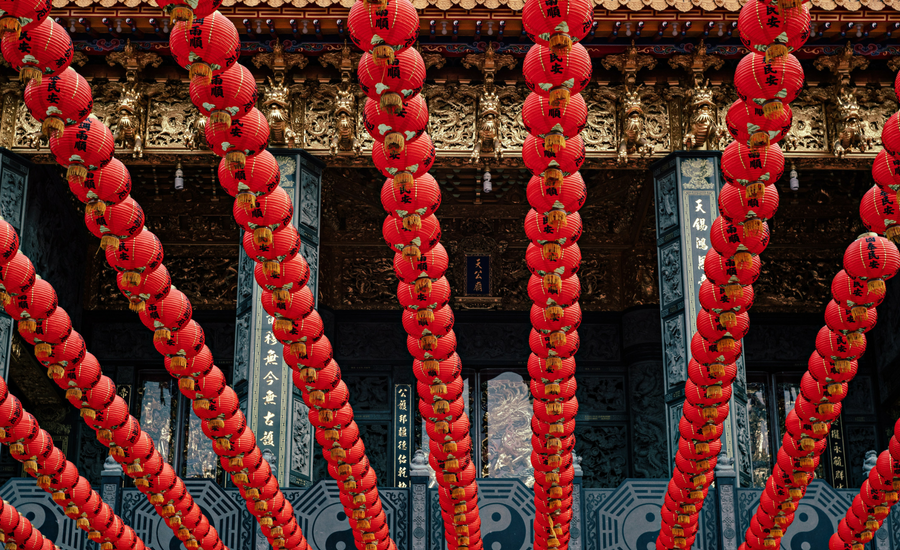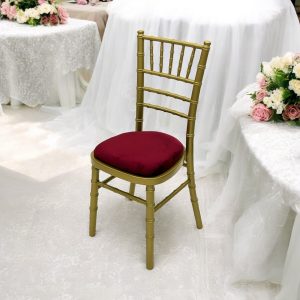In Chinese and Asian cultures, red and gold are more than just colours—they symbolise joy, prosperity, and success. These rich, vibrant shades have long been at the heart of celebrations, from weddings and banquets to New Year festivities and grand events.
We understand the importance of creating the perfect setting for special occasions at BE Furniture Sales. Our red and gold banqueting chairs offer an elegant and timeless way to enhance event venues, ensuring every occasion feels prestigious and culturally significant.

Red & Gold in Chinese & Asian Culture
Red
Red is one of the most powerful and auspicious colours in Chinese tradition. It represents happiness, good fortune, and success, making it a staple at weddings, Lunar New Year, and other milestone celebrations. The use of red extends to décor, clothing, and even symbolic gestures—such as gifting red envelopes filled with money to bless recipients with prosperity.
Beyond its festive associations, red is also a protective colour, believed to ward off bad luck and negative energy. This is why it is often used in traditional decorations, from lanterns to door hangings, bringing warmth and positivity into every space.
Gold
In many Asian cultures, gold symbolises wealth, prosperity, and high status. Historically, it was reserved for royalty, as seen in the golden rooftops of the Forbidden City and the luxurious golden robes worn by emperors. Today, gold remains a colour of prestige, often paired with red to create a sense of balance and grandeur.
When combined, red and gold represent a perfect harmony of joy and success, making them the ideal choice for event décor. Whether it’s a wedding banquet or a corporate gala, these colours set the stage for an unforgettable celebration.
Timeless Setting with Red & Gold
Red and gold remain popular for event décor, instantly creating an air of opulence and celebration. The bold warmth of red paired with the refined shimmer of gold adds a sense of luxury, making any event feel grand and significant.
Imagine a beautifully arranged venue with red table linens, gold-trimmed décor, and elegant red and gold banqueting chairs. The setting instantly transforms into an immersive space reflecting tradition, elegance, and prestige.
Blending Tradition with Modern Style
While traditional Chinese and Asian weddings often feature deep red tones with gold accents, modern event styling allows for greater creativity. Some venues opt for subtle gold details with a deep red focal point, while others embrace a contemporary fusion of classic and modern elements.
For a more understated look, golden banqueting chairs can be paired with red floral centrepieces or subtle red lighting. Alternatively, a more traditional setting may include rich red fabrics, golden embellishments, and intricate patterns inspired by Chinese motifs.
A Statement of Elegance
The choice of seating is a crucial aspect of event planning. Chairs aren’t just practical; they contribute to a venue’s visual appeal, helping to create a cohesive and well-thought-out space. Red and gold banqueting chairs, in particular, provide a regal and luxurious touch that enhances the overall event experience.
From traditional Chinese weddings to corporate events and banquets, these chairs help bring together the rich symbolism of red and gold, offering comfort and elegance.
At BE Furniture Sales, our red and gold banqueting chairs are designed with both style and durability in mind.
Versatile Across Different Events
Red and gold seating isn’t limited to weddings. These colours are used widely in cultural celebrations, award ceremonies, corporate banquets, and luxury dining experiences. Event planners often choose red and gold banqueting chairs for occasions such as:
- Chinese New Year celebrations
- Asian cultural festivals
- Corporate gala dinners
- Luxury restaurant interiors
- Exclusive conferences and award nights
For event venues looking to establish a strong, recognisable brand, incorporating red and gold seating can enhance the venue’s prestige and attract high-end clientele. Elegant, cohesive décor creates lasting impressions, encouraging repeat bookings and word-of-mouth recommendations.
Bringing Red & Gold to Your Venue
We offer banqueting chairs at BE Furniture Sales for purchase and our sister site provides banqueting chair hire. Whether you’re an event venue, wedding planner, or corporate organiser, we provide flexible solutions to meet your needs.
If you want to add a touch of elegance and cultural significance to your venue, our red and gold banqueting chairs are the perfect choice. Explore our range today and create a setting that captures the beauty of tradition with a modern touch.
For orders and enquiries, visit BE Furniture Sales or contact our team. We’d love to help you bring your vision to life.
Related Articles
- Wedding & Event Venue Bulk Buy Discount Chairs
- Chiavari Chairs Bulk Buy Discounts
- Banqueting Chairs Buying Guide
- Using Stacking Chairs to Save Space in Your Venue
- Event Seating Layouts

